Garmin Fenix 7X Sapphire Solar
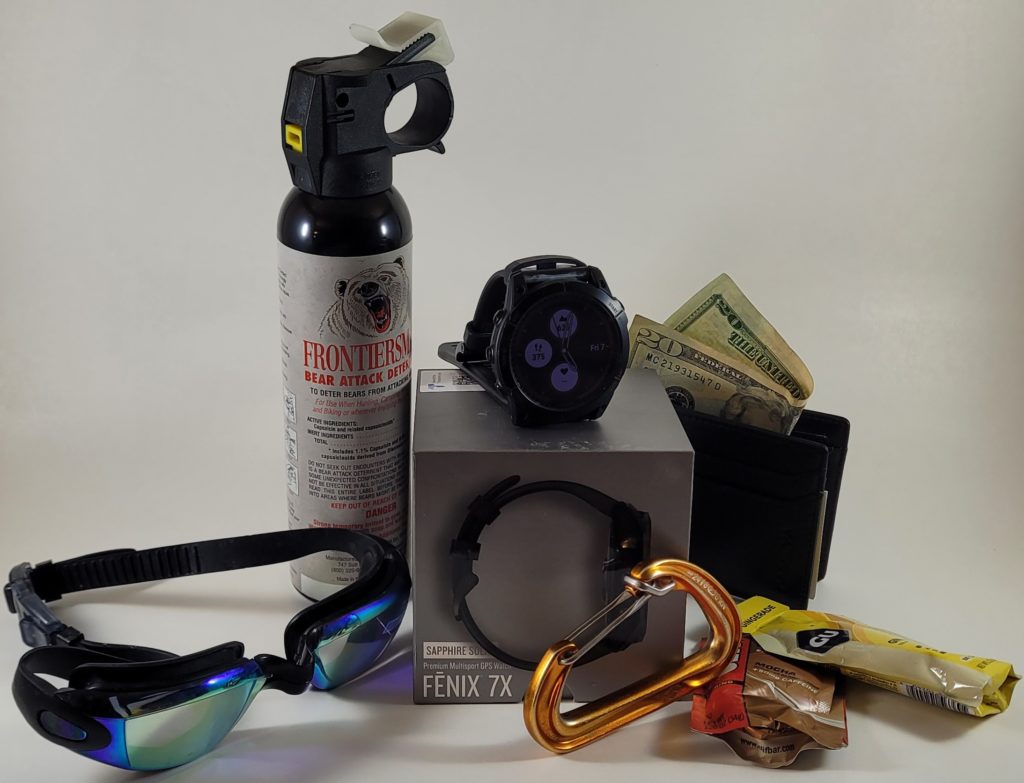
TLDR:
If you have the scratch and can make really good use of the features the Garmin Fenix 7X Sapphire Solar is amazing and has an exceptional battery life. However, it’s incredibly large on any wrist and prohibitively expensive.
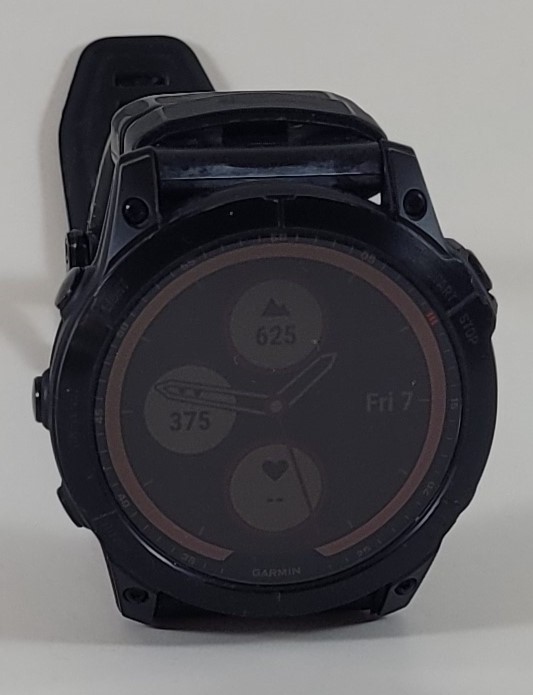

Background:
I’m not a smartwatch type of person and to-date they’ve held just shy of zero interest for me. However, I try to stay active and had seen some nifty specs from a friend who uses one so I looked into it. The Garmin was really the only consideration for me as I was more interested in their outdoor options and ruggedness.
That said, I have a history of destroying watches and through high school I’d go through about one or two every year. I’d scratch the bezel, wear out the buttons, snap the band springs or the bands themselves and interestingly, I’d wear through the chrome plating to the brass below and end up cutting my wrist. So, in 2004 or so I splurged on a Seiko Coutura with a stainless case and band as well as a sapphire crystal for $250 (on sale from about $500).
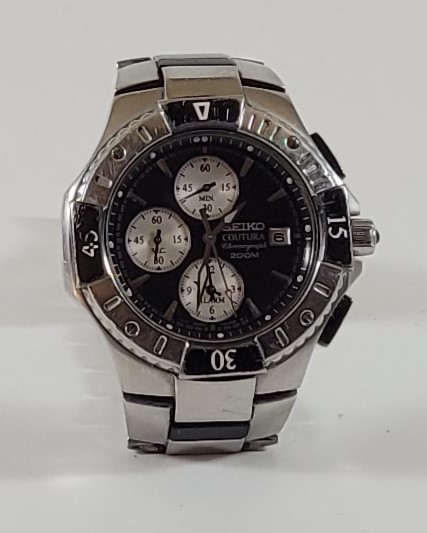
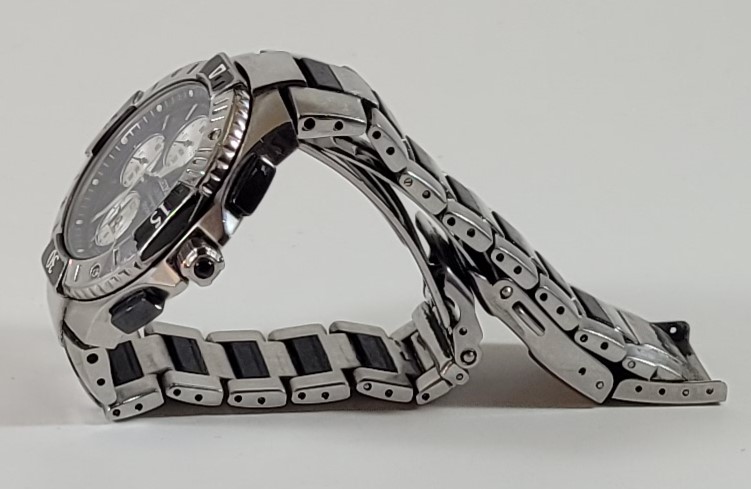
That watch has seen 120+ degrees in Death Valley, -20 degrees in Colorado, 30 feet underwater in the ocean to 12,000 feet on the mountains, mountain biking, mountain bike unannounced aerial dismounts, swimming pools and innumerable smacks against immovable objects. I’m on battery 2 or 3 with the original watch band having only repaired the band 2x when some screws came loose – $5 fixes at that. As you can see in the pictures, the screen remains unscratched 20 years later and overall the watch is in very usable condition, the only flaw being that I wore out the chip for the stopwatch (repairable). This is my baseline and I’ll have some comparisons to it and a basic digital watch for reference.
Additionally, I hate battery anxiety. Have to charge the phone every night, the GPS batteries lose power in freezing temperatures, the GoPro gives me 45 minutes per battery, and so forth. Given that I wear a watch daily, having to recharge it anything other than infrequently was a deal breaker, which significantly limited the options.
Why did I choose the Garmin Fenix 7X Sapphire Solar:
The following is not a technical review but rather experiential. There are myriad videos and articles online which can better get into the deep-dive specifications.
Quality GPS abilities, activity profiles specifically including lap and open water swims as well as triathlons, battery life, and durability all contributed to the value proposition. Luckily I also had enough gift cards and rewards points to be able to afford it. Jokes aside, that’s a huge factor to consider.
Who is it for:
This is where it gets more complicated but essentially experienced smartwatch users who do many and myriad activities. That said, the interface on this watch is very straightforward and it’s reasonably quick to learn the structural basics. The additional complexities, such as the differences between long vs short hold on the back button during and not during activities come with time, but pretty quickly. Thus, a smartwatch newbie like me can make good use of it pretty quickly.
However, it’s really not designed for said newbies.
First, it’s $1,000. For a watch not likely to last 20+ years like my Seiko that’s a ton of money. You really need to be able to make good use of the functionality for this to be of any value not available for many hundreds less. I will say that I’ll always pay extra for Sapphire over plastics and Gorilla Glass. The latter item has been a game changer in the cell phone world but there’s a reason we all buy screen protectors for our phones. I will not buy an expensive watch without Sapphire so for me, that’s worth the extra money. Side note for the adventures among us: I prefer a flat watch face because they’re reflective. It’s fun to annoy your siblings and play with the cat, but I consider it part of my emergency kit because I have a durably attached mirror to reflect the sun in an emergency. Yeah, the GPS options are great but expensive and not always on-hand. Not a make-or-break feature but one I’ve always appreciated. Plus it’s sapphire and won’t crack like my GPS screen did…
Second, the features on this watch are so numerous that unless you’re using it with frequency, multiple times per week, it’s a bit of a waste. Like buying a Ferrari but not actually driving it. But this watch doesn’t have the obvious stand-out panache of a Ferrari, where everyone instantly knows there’s something special going on. Look at the Tactix, Epix, Enduro, Forerunner, Approach or even the Descent, a dive watch. I was at a dive show and the lady at the boot tapped my friends Tactix and asked if it was a Descent MK2. Discerning eyes can tell the difference on some of these, but they’re so similar that in reality social visibility really shouldn’t be a driving factor. But outside of ego, if you’re not extremely active and/or outdoorsy and ideally either tech savvy or already well immersed in the smartwatch world this watch is a waste of your money.
Third, it can be overwhelming with a confusing array of details so unless you’re going to take the time to track the stats and use them to your advantage, you’ll be wasting your money. For example my most recent hike had four specs for pace (average, average moving, average grade-adjusted and best pace), four for speed, three for time, two for heart rate, four for training effects, two for cadence, four for elevation, eight for nutrition and hydration, and three for intensity minutes. Plus three other tabs with graphs, maps, summaries, etc. The watch tells me a bunch of this through a series of stat screens once I complete the activity but it also has a screen I’m hating because for an entire month it says my training status is overreaching. The aforementioned hike is the first time it said anything encouraging. It may be accurate but I don’t have to like it.
My experience thus far:
Controls are user friendly and easy to learn. There are 5 buttons but it’s quickly obvious what they do. Having both touch-screen and physical buttons is beneficial and the fact that they can be programmed to be active or inactive per activity is quality programming. I haven’t programmed any of that yet as the defaults are working for me just fine. Touch screen off during activities is fine for me since I can use the manual controls to navigate when I need to. The Touchscreen works as well as any cell phone I’ve used, I really don’t give it a second thought.
I really like the post-activity feedback from hiking to sleeping. I’ve found the sleeping feedback to about mirror my personal experience but it’s nice to put numbers to it. That said, even as a rather large man the size of the watch means I generally have an impression of the backplate on my arm and take it off for a bit while I get ready. I will say that I have become used to the size overall except when wearing cuffed shirts – I’m on the 2nd button and the shirt gets tight. Doable, but noticeable. EVERYONE will know I’m wearing this watch in a dress shirt.
Below are a few size comparisons of the Fenix, Seiko and Timex Ironman 30.
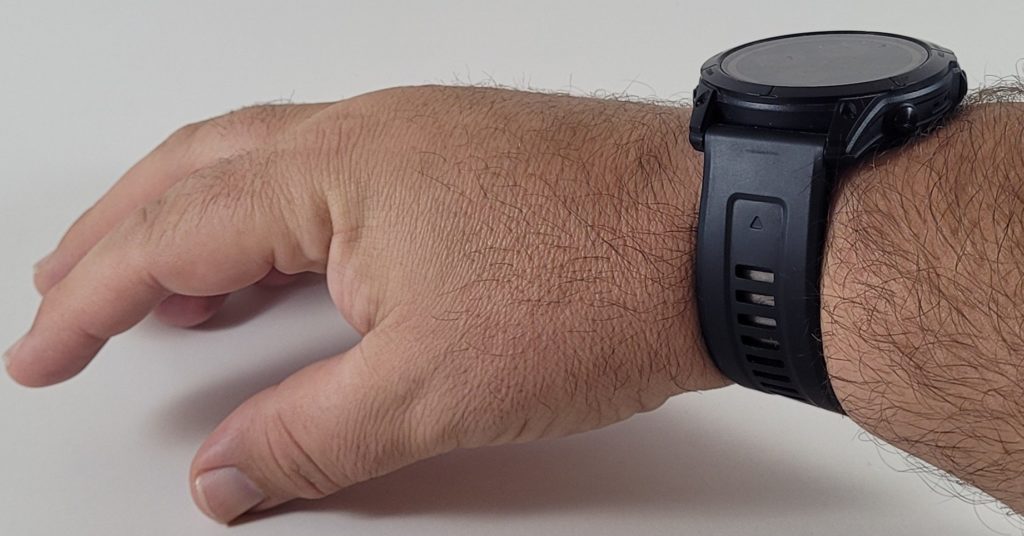
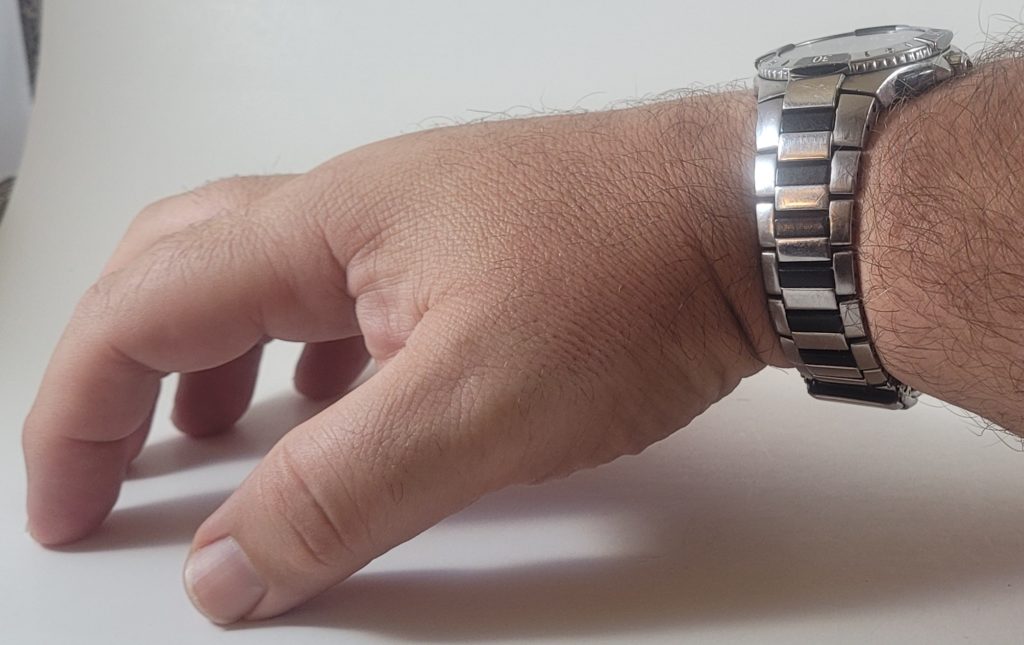
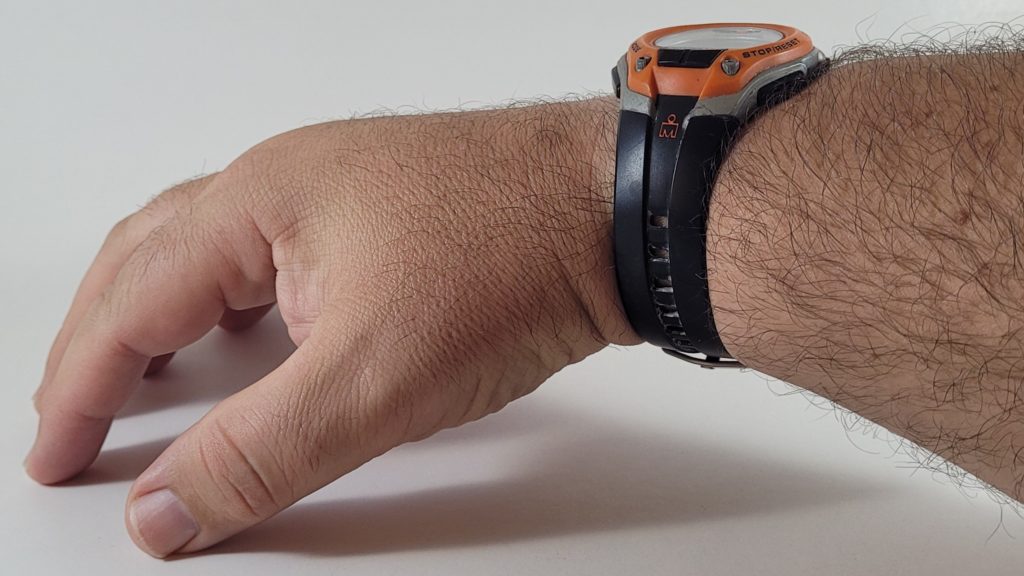
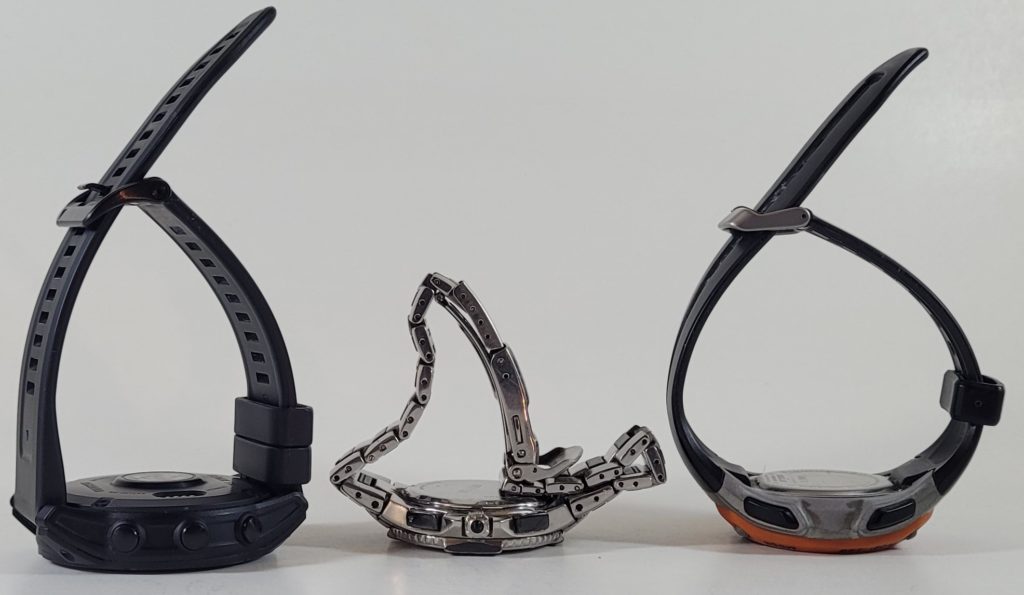

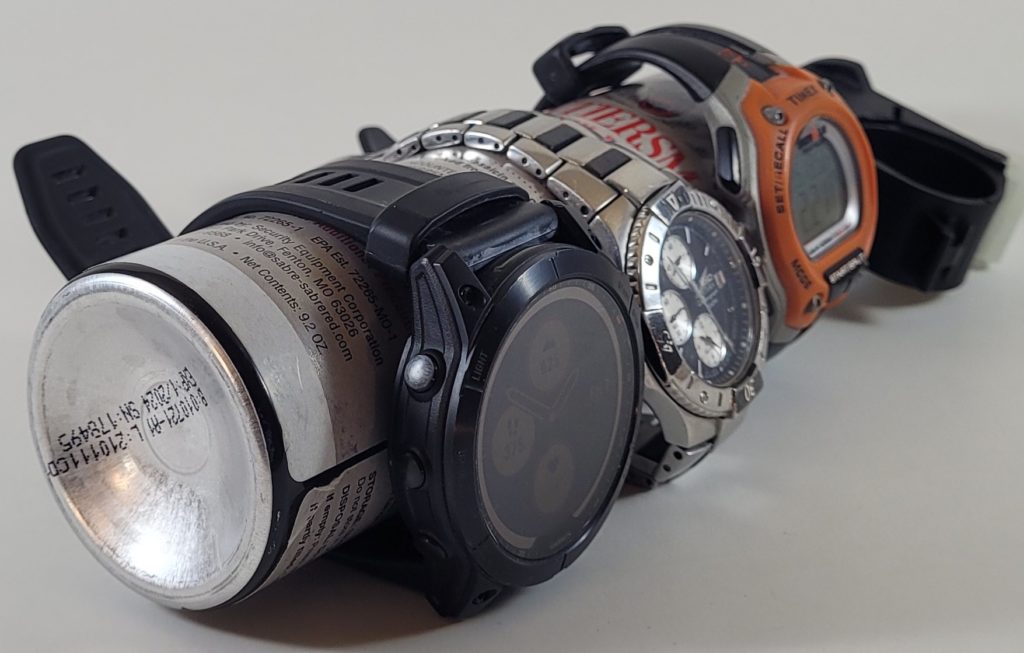
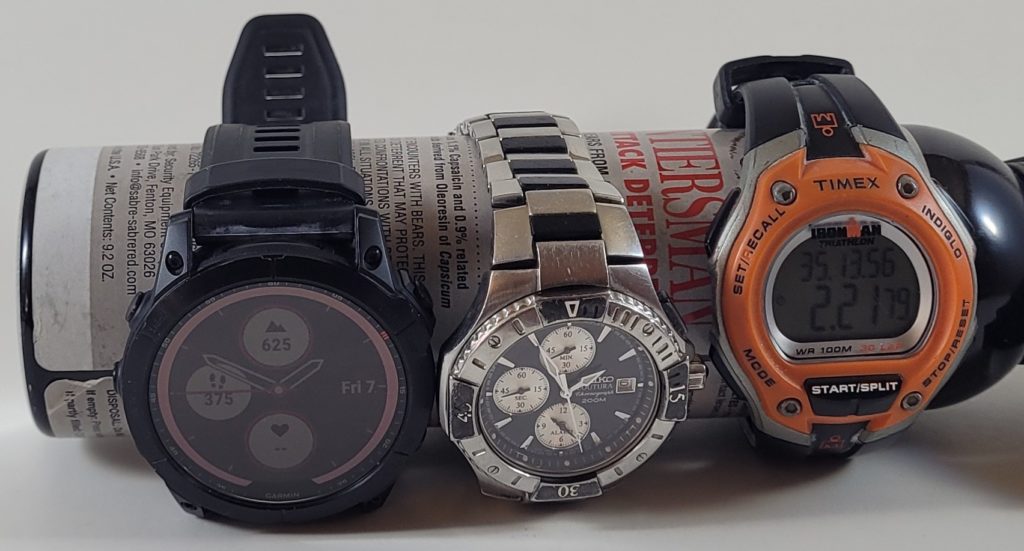
The brightness, or lack thereof is an issue for some people and I’ve read some reviews where they’d rather have the Epix with the bright AMOLED display. I’m sure it’s nice but I can’t live with the short battery life. The darker screen is most noticeable in situations like driving during the day where I can’t instantly see the details of the screen with a tilt of my wrist, or the readability of the smaller writing through my goggles when swimming. But since I really don’t need to know more than the time driving and I fog up every goggle I own, this isn’t an issue for me.
Apologies for the bad picture, I was apparently overdoing my exercise and couldn’t be bothered to take a good photo. You can also see the difference between being lit up and regular.
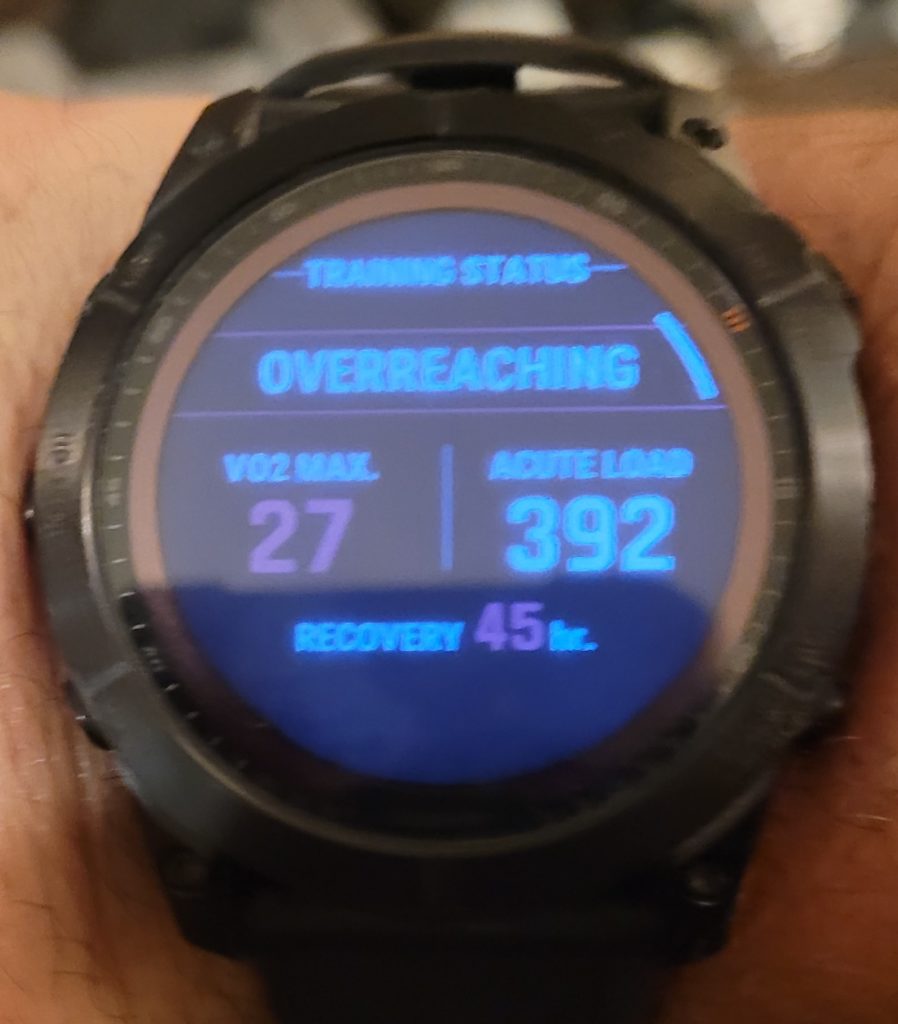
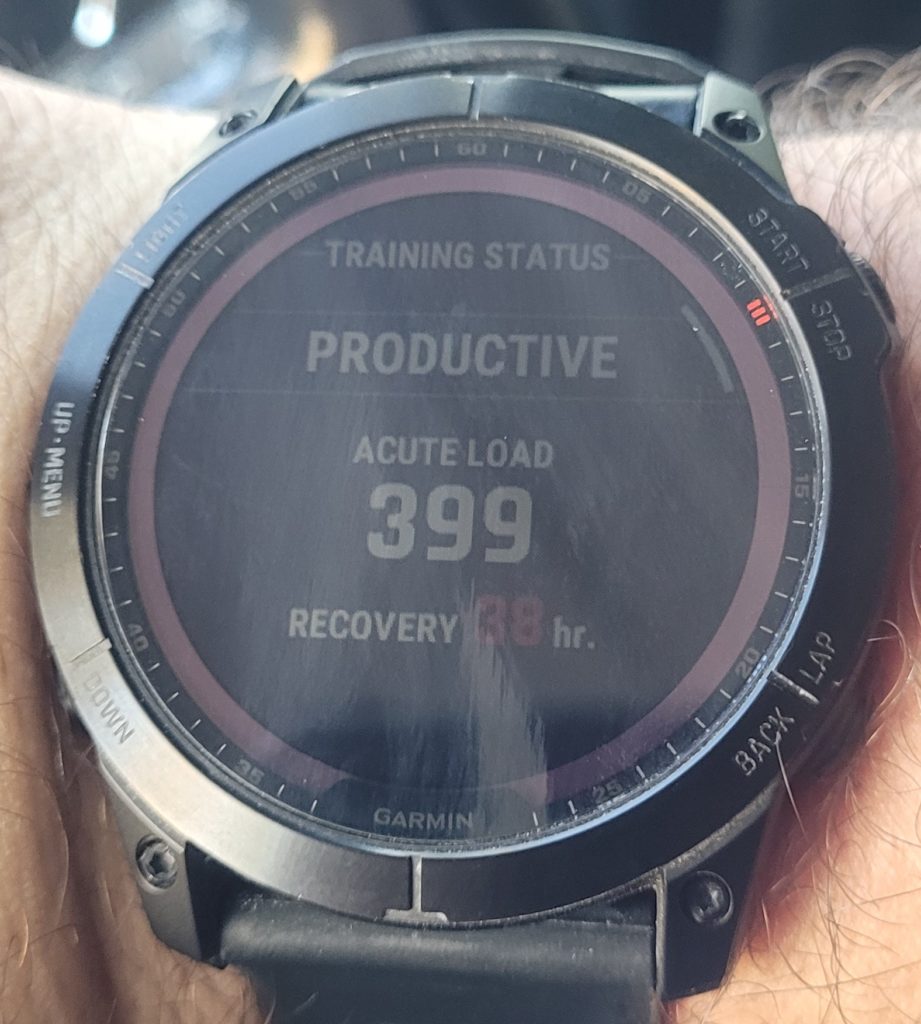
One side-feature I wasn’t expecting was the auto-light feature. I kept changing my watch to the regular dark background screen so I didn’t waste battery with the bright white walking metrics until I by happenstance I noticed that the screen was lighting up only when I lifted my wrist to look at it and then went dark when I put my hand down. It’s motion based so I could trick it here and there but it was always reliable to turn on. Neato.
This particular version has a flashlight with three brightness settings, a red mode, and various activity based combo flashes. Granted, you can’t just change the specs on the fly like a headlamp but it’s a non-issue. What’s interesting is that this stupid gimmick of a feature is a game-changer and I use it constantly. Used it on the 4th of July to find a hidden wick in a fire-work, was able to find my contact case in the back of a friend’s vehicle after he’d turned the interior lights off, in my tent looking for my glasses, etc. Think of how many times you whip out your phone for a little extra light, but now make it incredibly convenient, faster, and securely attached both to your hand and in a direction you need. I can’t imagine a smartwatch without a light now. Stupid on the surface but crazy convenient.
The silicone band is comfortable and the attachment design is well thought out. My friend has a bicycle handlebar mount and I like how he can simply pop it off his wrist, onto the bike, and back on his wrist. He’ll lose the physical metrics doing that but those aren’t always needed. Right now I’m more interested in those because I’m trying to focus my workouts and work on breath control. However, the band has two points of failure for me: Pain at the buckle and too short.
The pain at the buckle is just an issue with all buckled watch-bands and it creates a pressure point when I’m at my desk or sleeping. There are other options if I cared enough but the band is overall very comfortable and flexible so I’m not worried about it. The short band is annoying. There are 19 holes and I’m on 11-13 depending on various factors. That in itself isn’t a problem, but this leaves me all of ½” on which to slide the little watch tail holders. There are two on this watch, I can only fit the one. Granted, I have an 8.5” wrist and this is a perennial issue for me so your mileage may vary. Again, not a dealbreaker but when this band breaks I’ll look to replace it with an extended version.
The watch is reasonably accurate with it’s metrics for the various activities I’ve done thus far (swimming, walking, hiking) but pool lap swimming has been problematic. I think I’ve found the resolution but it wasn’t as straightforward as I’d have liked. I confirmed the issue by using my cheapo Ironman Triathlon lap watch and manually noting each lap (one back-and-forth or two pool lengths is one lap). The Fenix was basically doubling my distance which means every statistic is then wrong. I found the reason is likely threefold: Pace, pauses and stroke.
If you’re over 45 seconds per length (half lap) the watch will probably miscalculate. If you pause at any point during the lap swim the watch will probably miscalculate. If you do any stroke other than the freestyle/crawl stroke the watch will probably miscalculate. I know for certain it doesn’t like the breast stroke, usually only catching 25 out of 50 meters. Apparently the way the watch calculates laps is by the gyroscopic change in force when you hit the wall and change direction with a kick-off. When I train I usually do one warm-up lap of breast stroke and do a head-out-of-water turn and slow leg extension off the wall into an immediate stroke to increase the actual resistance and distance. I’m going for half to one mile swims and trying to simulate open water which doesn’t have walls off which to push. In short, wrong stroke, too slow. Also, I found a setting which includes pauses at the wall and that seems to have 90% worked. Still showed a distance of 625 which isn’t possible since I only swim in 50m increments but it’s close enough. In this case the $40 Timex is actually more accurate for distance, but only if I remember to press the lap button and firmly enough to make it count. The easy answer is to warm up out of the pool, don’t count the breast stroke lap (I usually don’t) and just get in shape enough to swim faster. I haven’t tried open water swimming yet but I’m aware of the issues that presents and may just attached it to a swim buoy instead of my wrist.
There are some side features I didn’t care about which don’t matter in the grand scheme of things but I do find nifty enough to use, such as controlling music playback on my phone and seeing email, text, and other notifications. Seeing the notifications is mostly handy because I can choose to ignore or respond without actually having to whip out my phone. This increases my ability to concentrate because the 2 seconds to look at then away from my wrist presents no distraction temptation versus the supercomputer in my pocket which has the chronically online crack cocaine of social media. I’ve paused my music from afar when someone knocked on the door, generically responded to a text to follow-up later, and even answered my phone from the kitchen while I walked over to pick it up. Where I’ve found it most helpful is the previously mentioned decrease in distractions but also in pausing the music in my earphones to listen to an announcement and then restarting, without removing my phone from my backpack, reducing the volume, or taking out my earphones. Not features worth $1K but they come along for the ride nicely.
Speaking of coming along for the ride, I don’t know how useful the solar functionality is. It’s not like I take the watch out for a hike at 90% and it’s at 100% when I return 4hrs later, but it has to be doing something, right? It has stats to show how much it’s getting and it’s better than nothing but I’d assume it might give me another day added to the legit 20+ days of battery life. I’ve yet to kill the battery but I have confidence in it. If my phone was at 30% I’d be reluctant to go anywhere I’d have to rely on it. 30% on this can last me a week, or close enough that I don’t give it a second thought. It’s worth noting that the watch has a proprietary charger and the cable it comes with is a foot and a half long. I can mostly forgive the proprietary charger since the design is waterproof (plugs into four recessed brass prongs) but this means you better buy spares at some point. Considering they seem to run $10 online, if you can afford this watch, you can afford some spares. Don’t love it, but can live with it for now.
I haven’t yet downloaded music, linked it to Spotify, added Garmin pay, or downloaded GPS routes for it but a few of those are on the list. I’m not concerned because it’s just another learning curve on a fairly straightforward device and I’ve had a good experience thus far. Side note: For those of you who wear tinfoil hats in sizes similar to mine, you do not have to go be online to use this watch. However, your use and enjoyment of the features will be curtailed significantly so if that’s you I’d recommend something cheaper and/or more offline.
In the end the intersection of price and features will make the determination. I’m almost active enough to warrant the features but the price was a non-starter until I got lucky. The watch works well and reliably, is straightforward to use and provides immense of value to those who need what it offers but if you have to look up VO2 Max, Swolf or EPOCH and are price sensitive this might be overkill for your needs.






Comments are closed here.